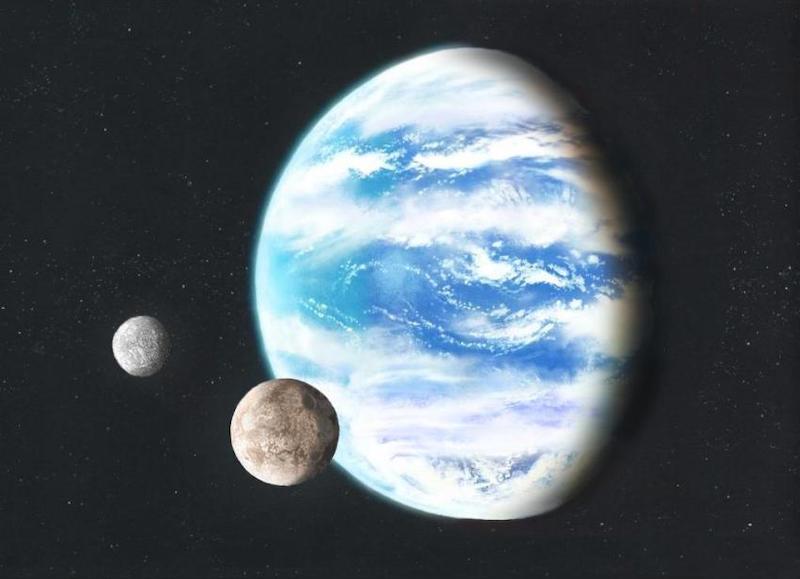
Land on exoplanets key to life
Factors affecting the habitability of distant worlds include things like its composition, its surface temperature, the makeup of its atmosphere, how much radiation it gets from its star and more. Now a new study – released July 11, 2022 – suggests another factor: the location and amount of its dry land. Researchers at the University of Toronto in Ontario, Canada, said their new climate model addresses the issue of land location and amount as it affects a rocky planet’s habitability. The study focuses on Earth-mass rocky planets orbiting M-dwarf (red dwarf) stars.
Graduate student Evelyn Macdonald at the University of Toronto (previously at McGill University) presented the results at the National Astronomy Meeting (NAM 2022) in the U.K. on July 11. The researchers published their new peer-reviewed paper in the June 2022 issue of the Monthly Notices of the Royal Astronomical Society.
There is also a free version of the paper on the arXiv preprint server.
Water worlds
Astronomers say a significant fraction of exoplanets – worlds orbiting other stars – likely have water on their surfaces. And those water worlds don’t always need to be Earth-like, either.
The amount of water will vary a lot from planet to planet, since no two planets will be just alike. About 71% of Earth’s surface, for example, is covered by water. Likewise, some exoplanets may have deep global oceans. And other worlds might be dotted only by lakes.

In addition, some planets are tidally locked to their stars. That’s where one side of the planet always faces its star, much like how one side of the moon always faces Earth. This can make it more difficult for the planet to maintain a balanced climate. That’s because, ideally, the atmosphere and ocean need to redistribute some of the energy received from the star, on the dayside, to the nightside of the planet. On a tidally locked planet, however, the heat would mostly remain on the side of the planet facing its star.
ExoPlaSim climate model simulates land on exoplanets
Now, the researchers at the University of Toronto say they have devised a new three-dimensional climate model called ExoPlaSim. The model simulates rocky, Earth-like planets with two different dayside scenarios. The two configurations are basically opposite of each other. In one, there is a circular continent surrounded by ocean on the dayside of the planet. In the second, however, there is a smaller circular ocean or sea surrounded by land everywhere else. This is a type of hypothesized “eyeball planet” where the ocean, or other prominent geographical feature, is centered on the star-facing side of a tidally-locked planet.
For both cases, the size of the cirlular area in the model varies. This is to show how the percentage of available land affects the overall climate of the planet. The model also takes into account the net precipitation, amount of clouds and surface temperature across the dayside of the planet. This applies for different land configurations. Although not included in this study (but referenced in the paper), dust can also greatly affect a planet’s climate by reducing temperatures on large, dry continents.
The researchers used 10-12 models at 20%, 40%, 60% and 80% dayside land cover.

Large effect on planetary climate
As the paper outlined:
A planet’s surface conditions can significantly impact its climate and habitability. In this study, we use the 3D general circulation model ExoPlaSim to systematically vary dayside land cover on a synchronously rotating, temperate rocky planet under two extreme and opposite continent configurations, in which either all of the land or all of the ocean is centered at the substellar point.
So, what were the results? The study showed that the location and amount of land does indeed have a significant effect on a planet’s climate.
When a planet has similar amounts of land on the dayside, but in opposite configurations (land surrounded by ocean or an ocean surrounded by land), the average surface temperature of the planet can vary by up to 20 degrees Celsius (68 degrees F). The area of ice-free ocean has a direct correlation with the amount of water vapor in the atmosphere.
As might be expected, if a planet has a larger amount of land, then the climate will be drier and hotter on the dayside. Clouds and rain are more confined to smaller central regions.

Prospects for life
The location and amount of dry land plays a big role in a planet’s potential habitability. And, of course, the more habitable a planet is, the greater chance that it might actually be inhabited by some forms of life. As Macdonald surmised:
Finding out whether life exists elsewhere in the universe is a key challenge of astronomy and science as a whole. Our work demonstrates that the distribution of land on an Earth-like planet has a big impact on its climate, and should help astronomers looking at planets with instruments like the James Webb Space Telescope to better interpret what they’re seeing.
Bottom line: A new study from the University of Toronto shows how the location and amount of surface land on rocky exoplanets affects both their climate and habitability. The study uses a unique new 3-dimensional climate model called ExoPlaSim to simulate Earth-like planets.
Source: Climate uncertainties caused by unknown land distribution on habitable M-Earths
Source (preprint): Climate uncertainties caused by unknown land distribution on habitable M-Earths
Via Royal Astronomical Society
The post Land on exoplanets: Where? How much? Both key to life first appeared on EarthSky.
0 Commentaires